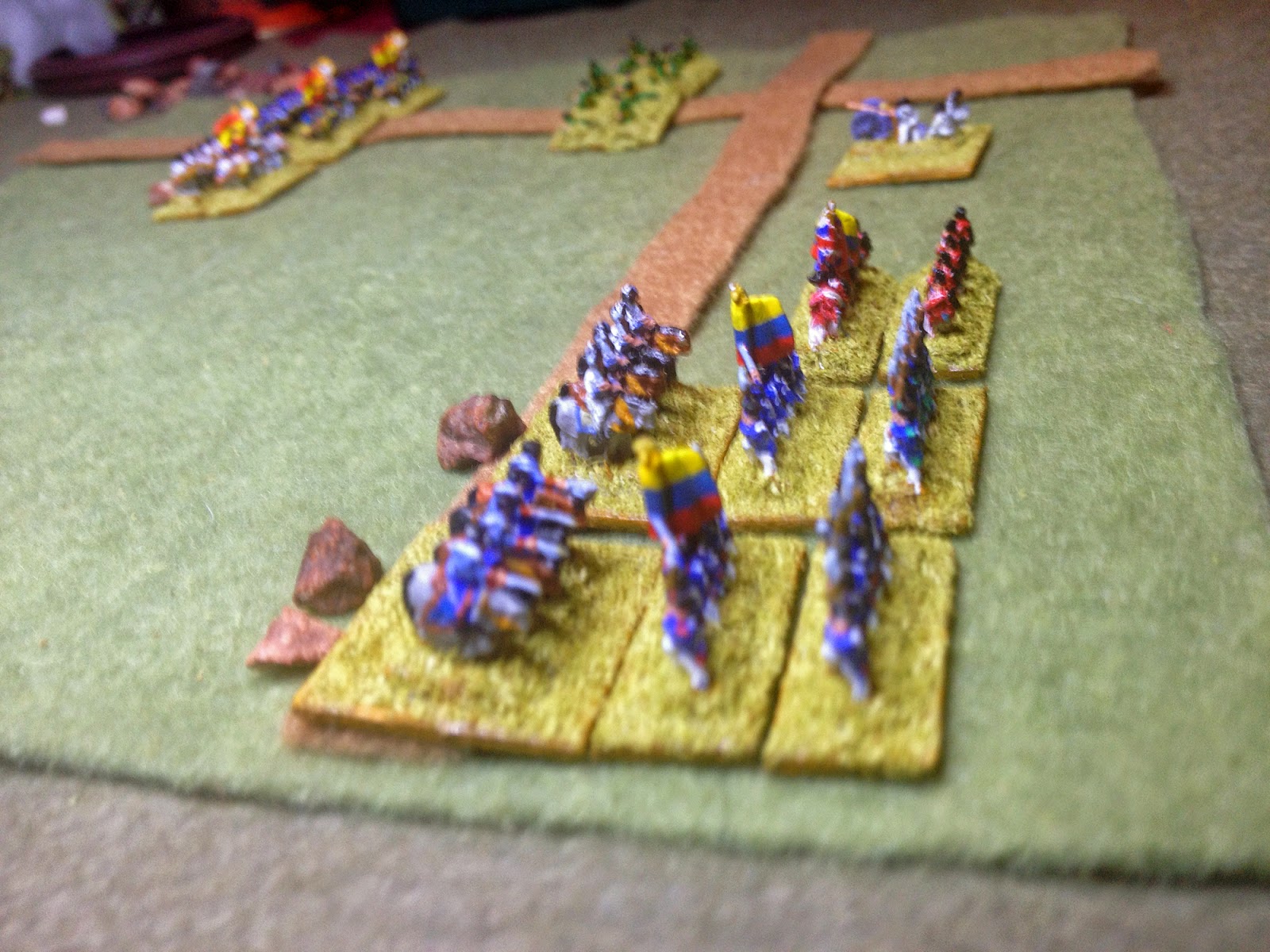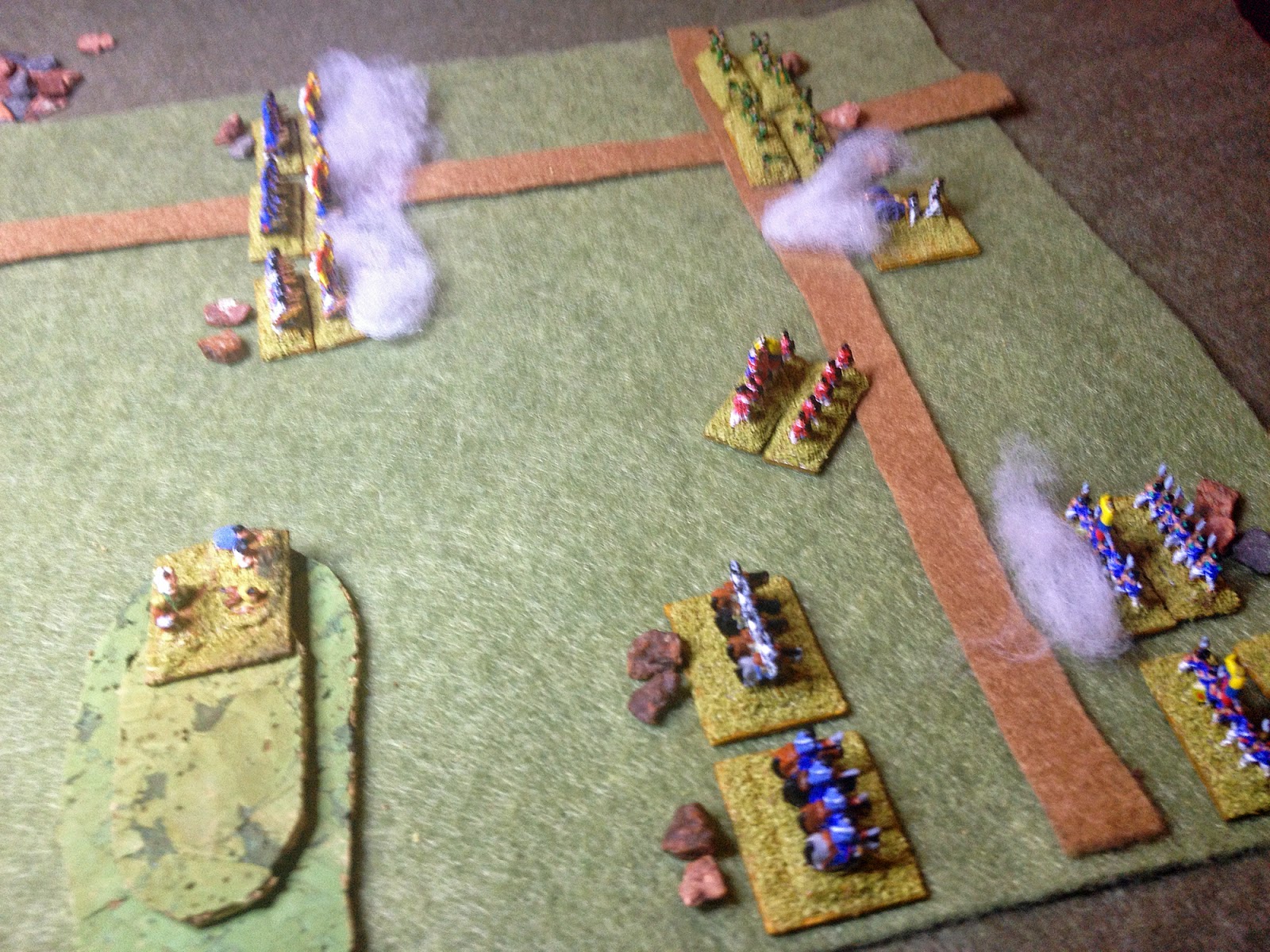The second scenario in One-Hour Wargames is another straight head-to-head fight. This time, however, there are a couple of objectives at stake - a hill in one corner and a crossroads in the other.
Once again I used Bolivar's Republicans against the Royalists. And, once again, I used the One-Hour Wargames Horse & Musket rules.
Well, almost ...
First off, I used a modified version of the combat mechanism I posted yesterday, which I tried out in a couple of games just to make sure it worked.
A unit attacking with 1D6-2 rolls 1D6
A unit attacking with 1D6 rolls 2D6
A unit attacking with 1D6+2 rolls 3D6
Each dice which scores a 4+ scores a hit.
Cover and armour save as before - roll 1D6 per hit and a 4+ means it's ignored.
A flank attack means that you double the number of dice you roll.
Units are removed when they have taken FIVE hits.
I think the odds of hitting are better than in the previous version, but units are a little tougher and there's still a reasonable change of inflicting no damage - in the original rules the fact that most attacks will score at least one hit makes them a little to predictable.
In addition I decided to play around with the troops' capabilities a little in order to add a little balance. In all of the nine sets of rules in One-Hour Wargames some troops are basically better than others, or have advantages that aren't always applicable to the scenario. This is probably realistic, in a way, but it does mean that there are some setups generated where you think 'Why bother fighting this at all?'.
So, cavalry are particularly good. They may not be able to gang up on enemy unit like those units that shoot can, but a couple of decent charges can usually see an enemy dealt with and then it's on to the next one. On a fairly open battlefield whoever gets the most cavalry will probably win. So I've reined them back a little.
Change 1 - After a cavalry unit rolls its attack it rolls a D6. On a 1 or 2 it loses its +2 combat bonus for the rest of the game (the horses are blown).
At the other end of the scale we have artillery, which is basically a bit rubbish. It has a good long range, and in some battles that's useful, but it doesn't score much in the way of hits.
Change 2 - Artillery rolls 1D6 at up to 6" (that's half musketry range).
Finally, we have skirmishers. Skirmishers are the only unit in the Horse & Musket rules which can enter woods. Half of the scenarios don't have woods. Yes, skirmishers also move faster than infantry. But that doesn't seem to hep them much in most games.
Change 3 - When an enemy unit or units declare an attack on a skirmisher unit, it may declare an evade. Resolve the attacks, but any attacks directed at the front of the unit halve the number of hits they score as if the skirmishers were in cover, although this stacks if the skirmishers are in cover). The skirmishers are then moved back 6" to their rear (like cavalry which are still in combat).
I tried out these changes in some test games, and they seemed OK. So I decided to go for it with my second Scenarios In Order refight.
And what armies did I roll? Well, the Royalists, who moved first, got three infantry, a skirmisher and two cavalry. The Republicans? Three infantry, one artillery and two skirmishers. This did not look good for Bolivar.
In previous goes at this scenario one side has seized the hill and sat on it, forcing the other side to attack. This was an option the Royalists had, but I decided to put the cavalry on that flank, charge over the hill and stop the enemy attack before it could start. meanwhile the infantry would advance on the crossroads, with the cavalry coming in to support them later. The skirmishers would just sit on the hill. The Republican plan was to attack the hill with their infantry whilst trying to delay the attack on the crossroads with the skirmishers and the artillery.
The Royalist cavalry charges.
And their infantry advances.
With hindsight it might have been better for the Republicans to have formed square, leaving the unsupported cavalry to go and find prey elsewhere or just sit their looking useless. But they didn't.
On the other flank the skirmishers took a right hammering from the advancing Royalist infantry. One of them was taking hits, it's true, but that was from the Republican artillery that's not in shot.
The cavalry back off, ready for another go.
Here's the game with added smoke garnish, and a few more hits.
In the middle one of the Republican units marches off to try and relieve the troops at the crossroads.
The cavalry responded by swinging that way as well, hitting the advancing unit in the flank.
One of the skirmishers was looking a bit weak now, and evading hadn't really helped.
The cavalry kept attacking. And kept passing the roll to see if they became blown.
The one Republican success - their artillery routed a Royalist infantry unit.
It then got charged by the cavalry, whilst the other unit, now blown, mopped up the remaining infantry unit. On the other flank the Royalist infantry calmly shot down the Republican skirmishers.
The objectives were almost irrelevant in this game; the Royalists won by just advancing and rolling over the top of the opposing army. This was really a function of the troops in use; I have played this scenario with ACW and GNW troops and it gives a fairly even fight, although personally I think it's weighted towards the side which starts with the hill, as they move first and have the more easily defended objective.
Two of the rule changes worked fine, that for cavalry and that for artillery. Although I used it in some of the earlier test game, the skirmisher evade ability wasn't really up to much, and is more complicated to state than I like. I shall consider something else for skirmishers including the almost taboo change of allowing them to move and fire.
Follow the rest of the scenario refights HERE














I found this series of posts very interesting and I really hope you continue with it.
ReplyDeleteI plan to test the H&M rules with D.Featherstone´s BWMS scenario. I have played it many time with other rules so I think this will give me a good comparison. I have to adapt the map to 3´ by 3´.
One of the things that attract me of this rules is that given the same playing area and scale, units can look better than DBA-HOTT (for instance).
You've convinced me to buy it. I'm wondering how well the scenarios will adapt to the Zulu War and the Black Powder rules. I have a lot of Zulus, thousands of 'em, and I've been looking for a sort of set of generic scenario templates that I can use.
ReplyDeleteThey should adapt OK to Black Powder. There's a group here that play a thing they call Black Powder 1-2-3, where they set up simple scenarios for six units a side, with the 1-2-3 mix being the proportions of the three troop types (infantry, cavalry and artillery, but not necessarily in that order). They seem to get good, quick, games out of it. I may even try some scenarios using Black Powder myself. I'm going to see how well the scenarios translate to a 12 element HOTT/DBA setup too.
DeleteCoincidentally I had my first go at OHW on Sunday with this scenario although I used the pike and shot rules. I thought the scenario was quite a good challenge (each side has to hold an objective and then get the other to win) and I enjoyed the game. However although the rules met the brief of being quick, which I liked, I did not think they really reflected P&S warfare. Firepower seemed very powerful perhaps not offset in my game by high rolling for the ammo out rule which meant reiters continued to blow holes in the opposition for longer. However I could tweak the rules with some of the suggestions here but I should give them another go first. As an aside I am enjoying your series of OHW articles.
ReplyDeleteI'm enjoying your series of OHW articles too, and hope you will continue to develop the original rules. I think you have managed to retain the simplicity whilst increasing the realism/period flavour successfully. Personally, I hope to use OHW derivatives for small ECW battles, but also to try and develop modifications for games in which units portray much larger formations, which I don't feel the original rules do satisfactorily.
ReplyDeleteFor a move and shoot rule, check out the rule for javelin-armed Units in my Dark Ages tweak of the rules at my blog: http://darkages40and25.blogspot.com/
ReplyDeleteIt's actually from one of his other sets of rules. I also did about 20 games including two with "cold" playtesters, to get the definitions of "contact" and such tightly written - as there were no rules for them, I had plenty of space in which to work, but little guidance.
I've found these rules very hard to tweak and keep simple. I was also considering simplifying the hit system and bring it down to three hits - Great Minds Think Alike?? Hmmmmmm.
Anyway, there's no reason that you can't use the javelin rule, it serves the exact same purpose, and makes Skirmishers more useful and survivable in open terrain scenarios. I also happen to think that my tweak is more historical. Cheers!
I've been enjoying following your tweaking of the Dark Ages rules. Simplicity is easy to maintain, as long as you remember that simple rules don't have to be short; it's better to explain something thoroughly so that people get it and can then apply it wherever it occurs, than to summarise and leave people wondering about the bits still inside the author's head.
DeleteThe main thing with modifying the hit system is that it's possible for any unit, regardless of circumstances, to inflict zero hits on the target. This means that any unit potentially has infinite durability under fire, however unlikely that may be in practice.
I'm looking at adapting and stealing a few things from your rules. I am quite drawn to skirmishers moving and firing, but I'm not sure about it happening in the movement phase; I like all my combat in one place. So, essentially, my skirmishers would only fire at the end of movement. And I was going to have it take place at a reduced range as well.
Line of sight, and target edges are still something I'm working on, although like you I am basing things on the centre of the edges at present.
I played some solo H&M games, all with the "Rules as written"
ReplyDeleteEscenario 2 (hmmm, not very interesting). This was played using Battle Chronicler.
Two times Don´s Featherstone BWMS sample scenario, using the same armies and deployment of the book. Both games were far more interesting than the first. Much more maneuvering, I think it was because of the presence of some obstacles and cover. I played one with BC and the other with an small improvised board and counters.
I am ready to play "Sawmill Village" with BC.
I have posted some pics taken from the software: http://theminiaturespage.com/boards/msg.mv?id=338249&page=2
Regards.
Those look excellent!
DeleteThe rules do make firepower quite deadly, and without cover units take hits very quickly. This is why I've been working on a way of reducing the amount of damage inflicted, but still allowing combat to be decisive. It's a difficult balance to strike.